
HorizontalMike
in almost 12 years
Compatible Woods in Small Boxes
Picked up a couple of 1/4" sheets of Ganadillo (janka=2450) at WC this past week. Planning on making a finger joint box L16" x W5-3/4" x H2-3/4" with hinged lid and insert bottom. I am currently planning on having a dado’d bottom insert (floating).
QUESTION: I was thinking about using a scrap of Soft Maple (Janka= ~1000) to make the 1/4″ × 5-1/2" bottom insert. So would the wide difference in hardness make this combination unwise?
How about a 3/8" rabbeted bottom insert? While I doubt the Granadillo will shrink/swell that much, I was wondering about the Soft Maple movement…?
FWIW, I have some single veneer 0.2" available AND some multi-layer as well.
HorizontalMike
27 Replies
Don’t know if I am biting off more than I can chew, but I just picked up these Granadillo boards for making a small finger-joint box. I know the going wisdom is to not use this thin of board for box-making, but I couldn’t resist!
Help me out here. I would like to incorporate either the Ash or Maple into this box. Got the box-joint jig worked out for the sides. I am “assuming” that I will need to either laminate the tops and bottom and/or make the top a lift-off top. Trying to hinge 1/4" boards appears to be an obstacle at the moment.
I want to finger-joint the sides, but am OPEN to ideas for top and bottom joinery.
- Thinking of laminating the bottom, cutting a rabbet that would flush with the bottom of the walls and fit in a dado in those same walls.
- Should I think about doing same for top and then cut off top? How should/could I hinge 1/4" walls to top? Hinging is my big concern…
- Should I consider making the base out of a more massive piece of ash/maple dado’d to fit the outer walls of the box? And maybe a matching lid frame w/Granadillo insert? Still how to hinge?
Any problems joining/laminating hard and soft woods together? Anyone done this?
Granadillo = 2450 janka
White Ash = 1360
Soft Maple = 1000
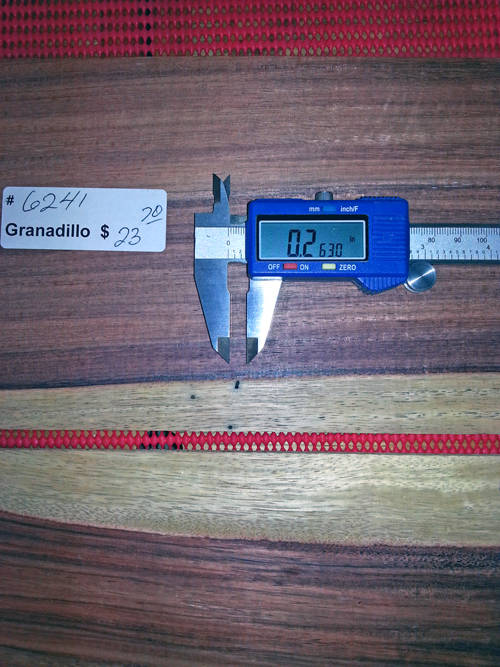
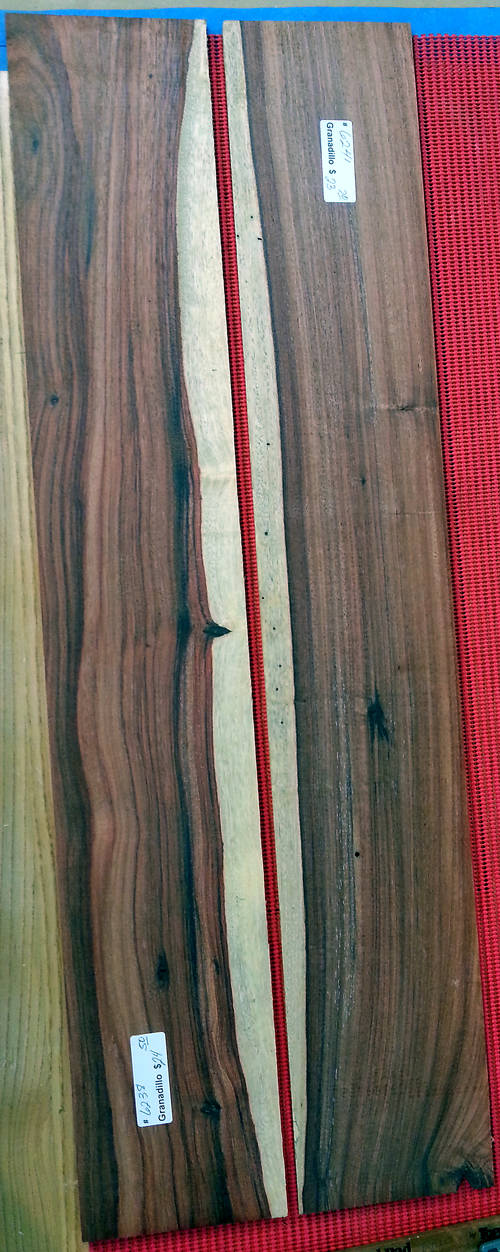
HorizontalMike
The wood looks great.
I would make a floating bottom with probably a 1/16 deeper dado.
With the width at 5 3/4 I don’t think there would be much expansion especially for a box that is going inside a house.
I could not find the granadillo expansion rate but here is a good link to calculate expansion: it has maple and ash expension rate.
http://www.popularwoodworking.com/tricks/how-to-calculate-wood-shrinkage-and-expansion
given the dimension and some of the ash and maple expansion coefficient, it will not be a great movement .
Abbas, Castro Valley, CA
Thanks for the link, now have it bookmarked. Looked online a bit and found this on a site that is in Austin, just an hour away. Not sure exactly how to interpret the movement, other than to think it is talking about movement from harvest-to-dried state. Doesn’t seem like useful info for already dried wood.
http://savagewoods.com/granadillo-wood/
Specific Gravity: 0.79
Hardness: 2450 Janka
Density: 63 pcf
Tangential Movement: 4%
Radial Movement: 2%
Volumetric Shrinkage: 6%
Durability: Excellent
I think 1/16" dado sounds about right for a floating bottom of granadillo, but was wondering if I might be able to laminate some maple/ash to that bottom plank and do a combination of rabbeted(maple/ash) and the dado’d grandillo? Now thinking about having a maple/ash skirt-base and sides with the granadillo on front, top, & back.
Personally, I don’t feel very creative and have always preferred following others’ plans/designs, and making slight alterations as needed. This is a brave new world for me, actually trying to “design” something… Been Googling finger-joint boxes and see just how varied things can get. Hmm…
Oh yeah, another thing I like about these boards is that the appear to be quarter-sawed, and should remain flat w/out cupping. 8-)
HorizontalMike
I can’t help you out much here, but that is some beautiful looking wood. Good luck on your build.
Losing fingers since 1969
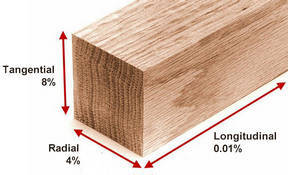
Picture does not refer to granadillo.
picture came from this site: http://workshopcompanion.com/KnowHow/Design/Nature_of_Wood/2_Wood_Movement/2_Wood_Movement.htm
The 1/4 per 12" tolerance in the article probably refer to a wood that move most; I am thinking pine or the likes.
I think you have to worry of the bottom and the top only.
longitudinal and radial, I usually ignore.
Tangential is the beast. That’s usually where the width of the stock will be substantial. again with your stock dimensions, it is still a small movement.
Quatersawn, if I remember correctly, alleviate the wood movement.
in your case ash or maple movement would be very similar.
I am blessed to be in the San Francisco bay area where we do not have too much swing in humidity. Texas would have some more variation. The only time were I sweat for wood movement was for my outdoor picnic table.
Rabbeted or not the wood is going to move. Ash/maple and granadillo move at different rate.
Laminated strips of contrasting color could add some nice element to the design. Sketchup or photoshop couldbe useful to determine the final look. I personaly use the color printer combo I have. Cut and glue:)
I would just add a piece of ash next to my stock and see how it looks. you first picture on the red mat made me think padauck might work. Maybe too intense..
As for design and creativity, I am on the same camp as you.
I usually ask my wife’s opinion. Logic and design together is rare. I say let you idea flow. The wood you are starting with is beautiful.
The bottom is not visible from outside so I don’t care so much for it. the inside is usually lined with fabric/padding.
My boxes bottom has always been plywood.
Abbas, Castro Valley, CA
Thanks Lanwater, many things to think about. I am beginning to think about using either the ash or maple in more substantial ways in order to accent the Granadillo. Yeah, top/bottom are my biggest issues, though I am not against adding/gluing a small block near each hinge. The hinge screws are ~3/8" tops and the Granadillo is 1/4". Beyond that, I am completely open for suggestions. BTW, Chicago screws are too big unless I go with really big/larger hinges to accommodate the heads of even the smallest ones.
All I know is,… Geez! I am NOT an artist! I struggle for “craftsman” at the very best! I just wanna’ have fun… 8-)
HorizontalMike
Have fun and good luck with the project Mike!
Abbas, Castro Valley, CA
Sometimes when getting ready to do a project we haven’t done before, we gather TMI (too much information) ,if you’re concerned about wasting hard to find wood, make a practice box out of pine or poplar and just go for it . If you’re doing woodworking for fun,then expect to make mistakes,take the fear and pressure out of the project,use each project as a learning experience.Enjoy!
I find so many folks are much more creative than myself ,so I often do the same thing as you Mike , I get inspiration from other folks work,there’s nothing wrong with that, unless we claim someone elses design as our own.
woodworking classes, custom furniture maker
OK, I just went back and looked at your reference image and “discovered”, after sleeping on it, that since the Granadillo is quarter-sawn the tangential axis is the 1/4" thickness.
So that means that tangential movement is just 0.01" at 4%. I am assuming (a dangerous thing) that that would be at the extreme range of humidity changes and not what one would see normally happen in a home. Plus, don’t very dense woods change moisture content very slowly as well?
HorizontalMike
I am sure that inside a house it will not be the higher end of the interval. Also the finish you put on, although not totally impermeable,
will prevent most of the moisture from going through.
I have a blanket chest I made about 5 years and glued one of the panel by mistake. By the time I realized what I have done it was too late to undo.
It still has not cracked on me.
I was hopping some of the more experienced member would chime in on this very important subject. Oh well!
Abbas, Castro Valley, CA
I am tempted to say 0.01 is probably less than the margin of error they had when the calculated those expansion rate in the first place.
Who ever measure it did not have the leisure to take a meaningful reading every few minutes to compute their mean value. I also doubt different shapes were taken into account.
The following book has some info on oil finishes and wood protection. I think it will help a little. it start around page 20 :
http://woodtools.nov.ru/books/Understanding_Wood_Finishes.pdf
Abbas, Castro Valley, CA
Well,… after much procrastination blah, blah, blah, I got off my 6 and started cutting up the Granadillo board. I was really strongly thinking about laminating 1/4" Soft Maple (as seen in the background) to all the Granadillo and go from there (so I could have ~1/2" thickness to work with. BTW, I have plenty of scrap Maple to do that.
FWIW, I adjusted my LxWxH in order to take care of 1/8" TS cuts and the like and judiciously cut up the first board and did a “mock-up” of the future box. Remember, this will be my FIRST finger-jointed box so I want to keep things simple. It’s only 1/4" thick (like cigar boxes), so it is NOT an industrial tested box… ;-)
Front Left
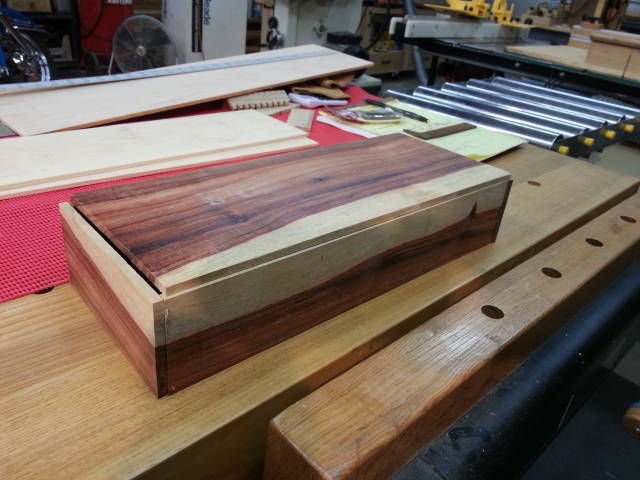
Front Right
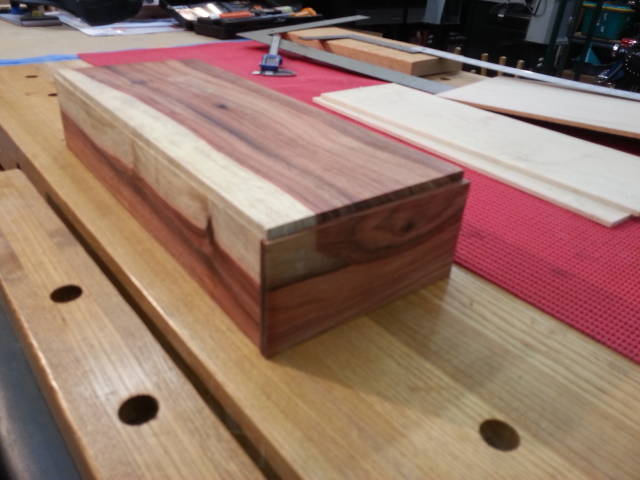
Back
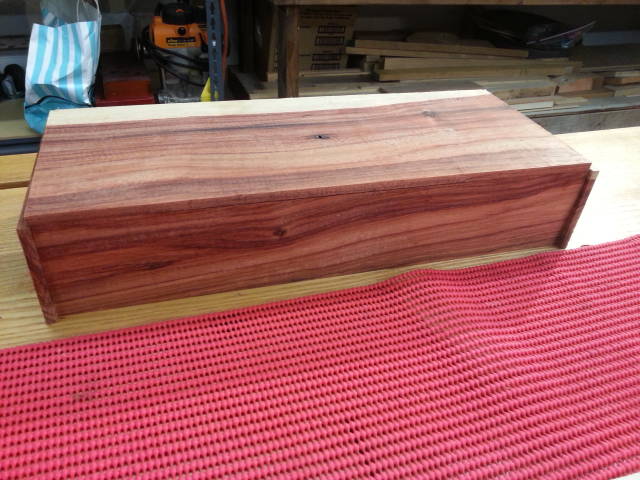
Oh yeah, I have the Maple to cut a piece for the bottom of the box (hidden until opened—and even then if felt covered, invisible). Shoot! Keeping it simple will allow me to make TWO similar boxes instead of one AND not waste any of the exotic wood!
Now planning on adding a laminated “button” where I need to attach the snap-catch as well as the two hinges, most likely in maple.
QUESTION: Do I actually need a skirt surrounding the bottom? Or leave it naked? Should I finger-joint the front and back “bottom” piece as well? I understand the possibilities are endless, but for small boxes I am a rookie!… Have mercy!…
HorizontalMike
Mike as per our discussion over the phone, the 1/4" is a great find but in my opinion the 1/4" is way to thin for box side walls I suggest you design your box so that the Ganadillo can be laminated to the outside giving it the illusion the box is made from the Ganadillo thus allowing for thicker walls, the lid you have a few options 1. Using contrast wood that lays over the entire box gluing and clamping. 2. Cutting 1/4" dados 1/4" down from the top edge and using your Ganadillo making it a floating panel lid. 3. Using your table saw blade and cutting 1/8 × 1/4" deep dados also 1/8" from the top of the side walls and than using a 5/8" thick piece of contrast wood also cutting the same 1/8″ × 1/4" deep dados so that he fits inside of the side wall dadoes, Note the last option is more complex.
Sorry I don’t have pictures or projects going right now to show you but my best advise is that you might try youtube and see if you can find something in the lines that I am talking about.
Randy - If I'm not on the computer than I'm out making sawdust.
Randy,
Now that I have something tangible to look at, I am thinking about partially doing what you are recommending RE 5/8" thickness.
What I am thinking of is, to build a mitered frame of Maple for both the top and bottom of the 1/4" box.
- Bottom: Cut a 1/2" rabbet on mitered pieces to not only hold the OSD of the box, but to additionally provide the support for an inside-the-box floating floor/bottom of same, in Maple.
- Top: Cut a ~5/8" dado’d miter frame in Maple so that the actual Granadillo piece will become a floating panel.
1. This will give me more thickness for the longer hinge and latch mounting screws.
2. This will also allow me to have the top overhang the sides a bit. May have to shrink the top panel for a best fit.
What do you think?
HorizontalMike
The bottom would work in that manor, another option for the bottom would take a solid piece of maple that is 1" wider on all sides and make an 1/8" deep inset using your router the the size of your box so that your whole box fits down in it, that way you wouldn’t have to build a floating bottom or cut dado’s.
The top sounds like it would work as well, I’ve made a box lid using that method.
Randy - If I'm not on the computer than I'm out making sawdust.
I have managed to rough cut some maple for the top frame/lid and have found it to have a nice curly figure. Wanting to “pop” the figure, I will need to choose an appropriate color of dye.
Question: Looking at the Granadillo above, what would be the “best” tone/color to treat the lid frame that will have a Granadillo insert?
I figure the dye will need to be a rather light color, and I want the dye to coordinate with the tone of the Granadillo without detracting from it. I am open to any and all ideas.
HorizontalMike
This question you ask Mike I can’t answer, That is my weakest point when it comes to matching woods it comes to my opinion that it’s something that only The builder can put together in his eyes.
Randy - If I'm not on the computer than I'm out making sawdust.
I am partial to a dark padauck with deep black veins.
I am sure it will steel the show.
Cherry: 
Eucalyptus:

cocobolo:
Some dark tone mahogany

maybe just some curly maple…
It’s going to be a terrific box.
Abbas, Castro Valley, CA
I don’t mean to flood your post but I found a picture on etsy for
granadillo and curly maple.
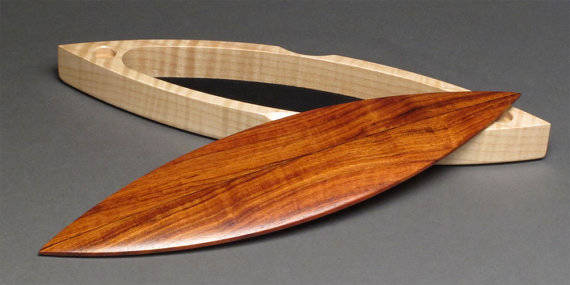
Abbas, Castro Valley, CA
I never dye my woods, I finish them in their natural color, though I use Tung Oil to bring out the flavors.
Randy - If I'm not on the computer than I'm out making sawdust.












